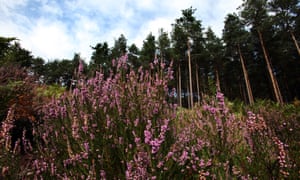Last century the Forestry Commission sparked anger with a mass planting of conifer trees designed to provide a national reserve of timber because the shortages of the first world war had highlighted a national need.
Now a leading expert is calling for similar action again, arguing that if the UK is serious about offsetting its carbon dioxide emissions it must plant tens of millions of trees from imported species on open land.
John Healey, professor of forest sciences at Bangor University, says that relying on indigenous species such as oak and beech will make it impossible for the government to hit its climate goals. Britain will have no choice, he says, but to engage with the commercial sector in large-scale planting of imported conifers, despite fears of the impact on habitats and wildlife.
Such a move risks incurring public anger, if its 20th-century precursor is anything to go by. “People felt it was bad for landscape, biodiversity and amenity,” said Healey. “Both the public and conservation professionals saw many negative effects on heathland; there was the notorious draining of the peat bogs of the Flow Country in the far north of Scotland; some really important habitats were left decimated by tree planting.”
In 2017 the UK was the second largest net importer of forest products, behind China. Yet only 1,420 hectares of woodland were planted in England in the year to March 2019, against the government’s target of 5,000 hectares. Wales and Northern Ireland planted 520 hectares and 240 hectares respectively.
The Committee on Climate Change has called for the planting of more trees and woodlands if the UK is to reach net-zero carbon emissions by 2050. It recommends increasing UK woodland cover from its current low level of 13% of total land cover to at least 17%, and possibly to 19% by 2050. In contrast, 38% of the average EU member state is wooded, a roughly similar percentage to the US.

The Conservatives have pledged to plant 30 million trees a year between 2020 and 2025. But Healey said such targets faced stiff challenges. Indigenous species grow too slowly to be an efficient option for rapid carbon fixation, he said. Unharvested woodland eventually stops sequestering carbon when it reaches maturity.
But conifer forests are harvested for timber, allowing new trees to be planted. He said: “The trees that produce this commercial timber and can grow in this country are virtually all non-native and are predominantly conifers from North America.”
The need to plant more trees is now an urgent priority to tackle the climate emergency. Mature tropical forests in Africa and the Amazon are slowing their rate of carbon dioxide absorption from the atmosphere and may soon become a source of emissions, as trees die.
Healey said it was time to be pragmatic. “Many people think we can have this huge expansion of tree planting in the UK and it will all happen without costing us as the taxpayer that much money. We also think it will all be nice, native species woodland of broadleaved trees and lots of biodiversity but it’s just economically impossible.”
“People and politicians have got to face up to the fact that the vast majority of this tree planting, if it’s to occur at the scale they have talked about, is going to have to come from commercial investments, and forest and environmental policy has got to avoid getting in the way of that unnecessarily,” Healey said. “Planting is catastrophically slow in England and Wales, and many commercial investors feel that they are held back from acquiring land and converting it to woodland because of the way that the whole raft of environmental and other policy regulations are implemented.”
Many endangered species – such as curlews and lapwings – depend on open habitats like moors and heaths.
“Everyone agrees that the best of these habitats should be protected,” Healey said. “But a lot of them are in really poor condition. Is restoration the best use of all this land, or should some, instead, be converted to conifer plantations or native woodlands? We need to ask how much of our heathland we need to protect or restore and how much we can convert to rapid carbon sequestration.”